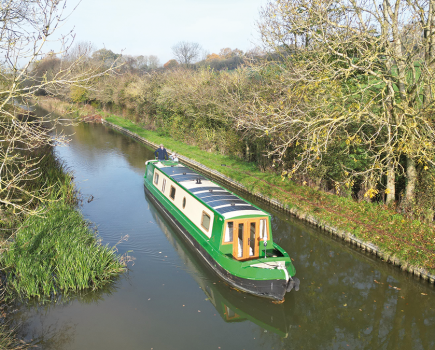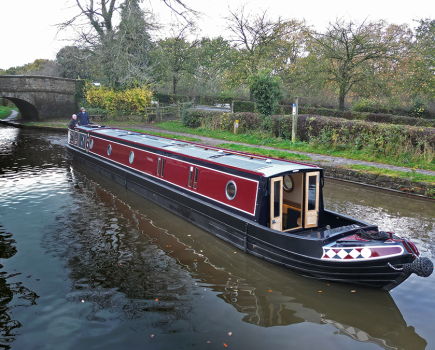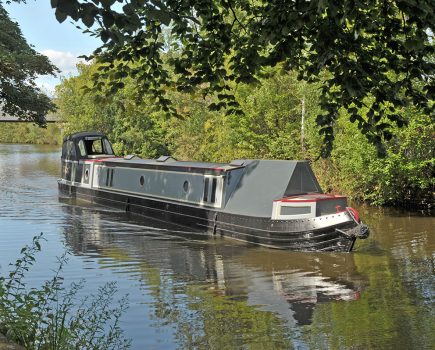If you think you have to break the bank to get exactly what you want, then think again – all it takes is a bit of thought, time and some legwork.

Have you heard the one about the man who set himself a budget of £100,000 for his bespoke 58ft narrowboat and managed to beat his target by almost £10,000? It sounds like a joke – after all, what comes in under budget these days? Not government computer projects, not new roads or railways, and definitely not those designer homes featured on TV programmes. And even the initial premise sounds suspect, because when it comes to new bespoke narrowboats, £100,000 (while a lot of money) doesn’t seem to buy a lot of boat these days.

In most tests we reckon £130,000 for a 58-footer is good value, and we’ve featured plenty costing a lot more.

But we’re not pulling your leg here. Steve Tabreham and his wife, Julia, wanted a boat for when they retire, but knew they had to keep the costs down or they’d never achieve their dream. And they’ve done it in quite a clever way – by being very hands on, doing a lot of the legwork themselves and making some sensible choices.

EXTERIOR
In spite of working to a budget, Steve was determined to order a good quality shell and immediately took to the people at Colecraft Boats. They built him a 58ft semi-trad, which is instantly recognisable as a Colecraft because of its bow which looks quite short and flared, and with a relatively dainty-looking stem post.

And it’s not just a standard shell, either. Steve has had T-studs at the stern rather than dollies because he finds them easier for mooring up. He’s also had a storage box built onto the roof which holds a couple of solar panels. So that the box doesn’t make the boat too tall, the height of the main part of the shell has been reduced by a few inches; this obviously has a knock-on effect on the headroom inside, but it’s still a very acceptable 6ft 4in, which is more than enough for most people.

The semi-trad stern has doors at the rear, and lockers down both sides. There are also rings, to provide somewhere for the couple’s two dogs to be secured. Access to the engine hole is via deckboards, which can be locked in place from inside. There’s a gas locker in the nose, while the well deck has more lockers on each side. The water tank is integral to the shell under the well deck.

One of the ways Steve and Julia managed this project was to order and buy many things themselves, starting with the shell. They ordered direct from Colecraft and they arranged for the boat to be transported to their chosen fitter. As well as building the shell, Colecraft were commissioned to go a stage further, and fit the engine and the bow thruster.

The boat was painted by Graham Ford, of Cherilton Narrowboats as part of the fit-out. The colour scheme is quite striking, with a green chosen by Julia to represent the grass of Hawaii because that’s where the boat’s name originates. Julia and Steve have travelled widely and wanted a name to remind them of their travels and shaka, or Hang Loose, is a common Hawaiian greeting. The sign writer, Robert Naghi, has done a great job with the artwork, not only on the panels at the stern but also with the little geckos on the bow flashes, who are also doing the ‘hang loose’ sign.

The mushroom vents and other trim are chrome to complement the modern look of the boat and to reduce the cleaning needed. The windows are by Caldwells and the double-glazed units can be lifted out completely, to let maximum air through on a hot day.

Keeping the interior light and bright was one of the couple’s main requirements, so there are Houdini hatches in the galley and saloon, and the doors on to the well deck have also been glazed with full-length windows.


LAYOUT AND FIT-OUT
Steve designed the layout of the boat himself. In a way it’s fairly standard with a saloon at the bow followed by an L-shaped dinette. Then comes the galley, with a wider than usual corridor through it. The walk-though shower room is next, with the cabin at the stern.

The couple chose Graham Ford of Cherilton Boats at Shardlow for the fit-out, took him their plans and were impressed by the way he was willing to build exactly what they wanted. Everything on board is handmade, including all the cupboards and drawers.

The fit-out uses oak, with tongue and groove below the gunwales and on the ceiling (this type of ceiling was one of Julia’s main requirements); the cabin sides are painted, to give a bright modern look. The floor is solid oak.


SALOON AND DINETTE
We’ll start our tour of the boat at the bow where the glazed doors bring you inside from the well deck. The steps have lifting treads for storage and on one side there’s a hearth and Villager stove, while on the other side there’s a corner cupboard.

The main feature of the room is a sizeable TV unit tucked under the gunwales, with slim cupboards either side and another underneath.

The dinette is raised slightly and has a table on Desmo legs. There are shorter legs for when this area converts into a guest bed. The base unit provides masses of storage.

Taken together, the saloon and dinette offer a big social space, something particularly important to Julia who is looking forward to having a boat full of children and grandchildren.


GALLEY
The galley feels immensely spacious, thanks to a clever design trick. While the units on one side are the normal depth, those opposite are only half as deep. This means the corridor between the two is wider than normal.

The couple learned this trick from a hire boat holiday, when they found it tricky to get past each other in the galley. The cupboards on the slim side still offer plenty of storage because they go under the gunwales which provide several inches of extra space. There’s a side hatch with glazed inner doors that also helps make the space bright.

The worktops are sparkly quartz, chosen to match Julia’s interior taupe colour scheme. There’s a milled drainer next to the stainless steel sink and the tap is connected to a Seagull filter for drinking water.

Equipment includes a Belling oven and four-burner hob, a 12-volt Shoreline fridge and a microwave. Two storage boxes set into the floor are kept cool as they extend down to the baseplate.


SHOWER ROOM
Perhaps the most unusual and personal features of this room are the stained glass panels in the doors that reflect Julia and Steve’s love of sea life and the travels they’ve made to watch it. One panel features a reef triggerfish, the national fish of Hawaii, while the other is a green turtle. They were commissioned from Bonnie Brooksbank at the Purple Stained Glass Studio.

On more mundane matters, the shower is a large quadrant lined with laminate, and alongside there’s a laundry drawer, a few shelves, and access to the shower pump. The loo is a Jabsco macerating unit, with a holding tank under the bed.

The basin is a smart white one, sitting on more quartz worktop and a sizeable cupboard. There’s also a heated towel rail and an extractor fan.


CABIN
The couple wanted a cross-bed for the extra width but didn’t like the idea of the mattress being piled up during the day, so Steve has come up with a simple system where a unit on the far side houses the mattress infill and provides a drop-down panel to complete the bed.

There are a range of cupboards and drawers so there’s plenty of storage for clothes. One of them, towards the stern, is a wet cupboard, with a heating pipe to dry damp clothes. The high cupboards above the bed head have dimmable LED lights underneath, which can be operated by a remote-control fob.

One cupboard contains a range of technical equipment, including a Wi-Fi router. It also has an ingenious system for the TV antenna. From this cupboard, the antenna can be raised by hand and rotated; a box of tricks tells you when it’s pointing in the right direction to maximise the signal. For anyone who’s used to standing outside twiddling an aerial and having to peer through a window to see whether a picture has appeared on the TV, this system seems like the height of luxury!

Steps lead up from the cabin to the rear deck and there’s an electrical cupboard on one side. The steps can be removed to give access to more cupboards.
TECHNICAL
A Beta 43 engine was another of Steve’s must-haves, because of its reliability and ubiquity in canal boats. Hang Loose is also fitted with a Vetus bow thruster, although Steve says he plans to use it as infrequently as possible.
The type of batteries fitted was also an area where he had strong views; he favoured traction batteries because of their ability to be discharged right down to 20 percent and their long life. So there are six two-volt cells providing 480Ah. For a 240-volt supply, there’s a Victron 3kW Multiplus inverter-charger, while two solar panels on the roof should help keep the batteries topped up. There are some nice touches to the electrical installation. There’s an ‘all-off’ switch that guarantees that everything is turned off when you leave the boat. There’s also a key system that can be removed if you’re leaving the boat for any length of time which should ensure that no-one can turn its systems on.
Heating is by an Eberspächer boiler. There’s even a system whereby Steve and Julia can send a text to turn on the heating and the lights – great if you’re travelling to the boat on a winter’s evening. The boat also has smoke alarms installed throughout.
ON THE WATER
With a shell by Colecraft and a Beta 43 for propulsion, there are few surprises with the handling, and that’s a good thing. The boat responds well to the tiller and goes exactly where it’s pointed. It turns incredibly well; we winded easily without using the bow thruster, and there was never any doubt about whether it would make the zig-zag turns through Mercia Marina. It also reverses pretty well in a straight line. As far as handling is concerned, there are no complaints at all.
The semi-trad deck means there’s plenty of space for both helmsman and crew, with the lockers providing somewhere to sit and to put your mug of tea down. The engine is pretty quiet, too.
All in all, steering this boat is a very pleasant experience.
CONCLUSION
So here we have a boat based on a shell by a respected builder, with a bright modern fit-out, and with all the gadgetry you could need. Setting a £100,000 target for a boat like this would already seem ambitious, but to beat that target by almost £10,000 is remarkable.
So how did Steve and Julia manage it? One big saving was their choice of boat-fitter. Cherilton Narrowboats is a small business, small enough, in fact,
not to need to be registered for VAT. By paying just for the fit-out work, the couple saved several thousand pounds (although even if they’d had to pay the VAT, they’d have still been just under
the £100,000 mark).
A major factor in keeping the costs down, though, was that Steve did a lot of the legwork himself, researching items and finding the best deals; visiting the Crick Boat Show and making the most of special prices offered by many manufacturers there.
But perhaps the biggest triumph is not that the boat cost just £90,000, it’s that it looks as though it cost a lot more. After all, this is a bespoke boat, not an off-the-peg one.
It’s proof that shopping around and careful budgeting really can make a difference to your build costs.
The Hang Loose – Specifications
£90,000
Length: 58ft
Style: Semi-trad
Berths: 2+2
Layout: Standard
Power: Beta 43hp
Verdict: This boat shows you can have what you want at the right price.
Image(s) provided by:
Archant







